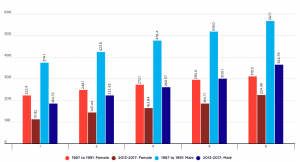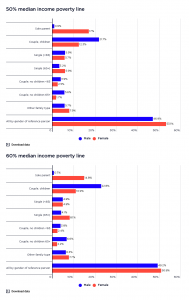This graph compares poverty rates among people according to the labour force status of the household reference person.
2017-18: People who are of working age but who are lacking paid employment face an elevated risk of poverty, at 66% using the 50% of median income poverty line and 76% using the 60% of median income poverty line. Where the reference person is aged under 65 and is not in the labour force, 45% of households are in poverty using the 50% of median income poverty line; and 56% using the 60% of median income poverty line. Many of these households have a reference person with a disability or with caring responsibilities and rely on payments such as Disability Support Pension, Parenting Payment or Carer Payment. Poverty rates are much lower where the household reference person is employed fulltime (6% using the 50% median income poverty line and 9% using the 60% median income poverty line). Since minimum wages are above the poverty lines for a single adult, those in households with a reference person employed fulltime living below the poverty line are likely to rely on a single wage to support a partner and/or children, or to be paid below the minimum wage. In support of this view, the poverty rate among households with children whose reference person is employed fulltime is significantly higher, at 10% in sole parent families (15% using the 60% median income poverty line) and 7% among couples with children (12% using the 60% median income poverty line). In these cases, fulltime wages together with Family Tax Benefits, are insufficient to lift families with children out of poverty. Households relying on a single part-time wage are more than twice as likely as those relying on a fulltime wage to be in poverty (15% using the 50% median income poverty line or 26% using the 60% median income poverty line). Among households with children whose reference person is employed part time, the rate of poverty is 11% in sole parent families and 20% among couples with children using the 50% median income poverty line, and 30% in sole parent families and 28% among couples with children, using the 60% median income poverty line.
2015-16: People who are of working age but who are lacking paid employment face a high risk of poverty, at 68% using the 50% of median income poverty line and at 78% using the 60% of median income poverty line. Where the reference person is aged under 65 and is not in the labour force, 45% of households are in poverty using the 50% of median income poverty line; and 60% using the 60% of median income poverty line. Many of these households have a reference person with a disability or with caring responsibilities and rely on payments such as Disability Support Pension, Parenting Payment or Carer Payment.




